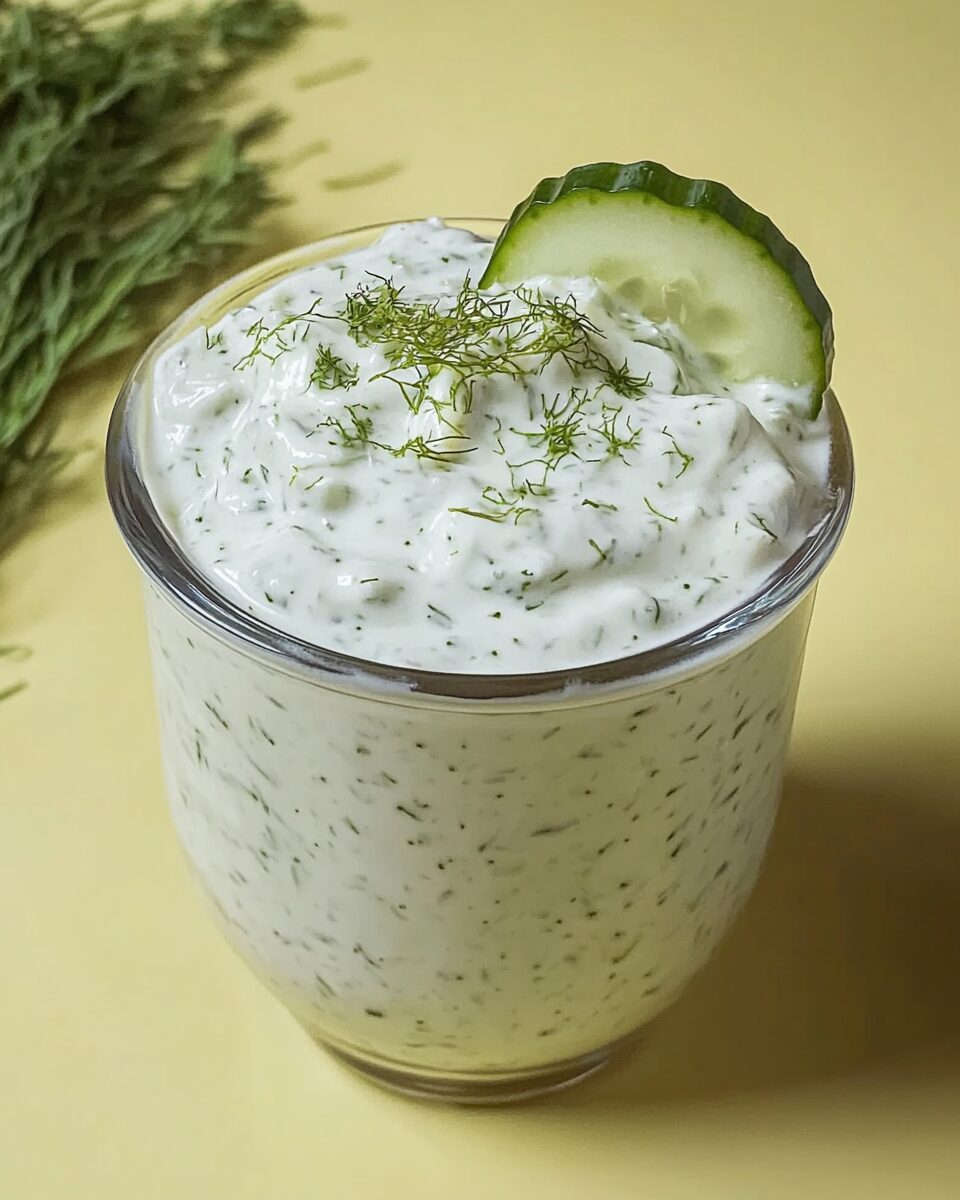The cool, creamy tang of this Tzatziki Cucumber Sauce pairs beautifully with the bold spices of Mediterranean cuisine. With its blend of fresh cucumber, thick Greek yogurt, and a hint of garlic, this sauce elevates any dish it’s served with—from grilled meats to roasted veggies, pita wraps, or even as a dip with warm flatbread.
What makes this version special is the subtle richness added by sour cream and mayonnaise, giving it a smooth texture and depth of flavor. It’s versatile, easy to prepare, and best when chilled for a few hours to let the flavors truly shine. Whether you’re planning a cookout, weeknight dinner, or mezze platter, this tzatziki is the perfect companion.
Full Recipe:
-
1 large cucumber, peeled and cut into chunks
-
1 ½ cups plain Greek yogurt
-
½ cup sour cream
-
¼ cup mayonnaise
-
2 cloves garlic, minced
-
Salt and pepper to taste
Directions:
-
Chop the cucumber in a food processor until nearly liquefied. Strain it through cheesecloth to remove excess moisture—be careful not to over-drain and lose too much of the fresh cucumber flavor.
-
In a mixing bowl, combine the strained cucumber, Greek yogurt, sour cream, mayonnaise, and minced garlic.
-
Stir until well blended. Season with salt and pepper to taste.
-
For best flavor, refrigerate for at least 2 hours before serving.
Prep Time: 10 minutes | Cooking Time: 0 minutes | Total Time: 10 minutes
Kcal: 49 kcal per serving | Servings: 22
A Deep Dive Into Tzatziki: The Iconic Cucumber Yogurt Sauce
Tzatziki is more than just a sauce—it’s a culinary symbol of the Mediterranean diet, packed with history, flavor, and versatility. This creamy, tangy cucumber yogurt sauce is a staple in Greek cuisine, but its reach and appeal extend across borders. Whether you’re enjoying it as a dip with warm pita, a topping on grilled meats, or a cooling companion to spicy dishes, tzatziki brings a refreshing balance to the table.
While variations exist, the heart of tzatziki lies in its signature ingredients: strained cucumber, Greek yogurt, garlic, and a touch of acidity or herbs. This specific version of tzatziki takes it a step further by incorporating sour cream and mayonnaise for a richer, creamier texture. The result is a luscious, velvety sauce that maintains the refreshing integrity of classic tzatziki while offering more depth.
A Brief History of Tzatziki
The roots of tzatziki go back centuries, tracing their origins through the Balkans and the Middle East. In fact, the word “tzatziki” comes from the Turkish word cacık, a similar yogurt-based dish, though the concept of combining yogurt with herbs, garlic, and vegetables is widespread throughout the region.
In Greece, tzatziki is a cornerstone of meze culture—small shared plates designed to accompany conversation and wine. Served chilled, it’s especially popular during the hot summer months when lighter, refreshing foods are favored.
Over time, the recipe has evolved to include regional twists. Some use mint, others prefer dill. Some versions are purely yogurt-based, while others, like the one we’re spotlighting today, enhance the creaminess with sour cream and mayonnaise. These modern adaptations honor tradition while catering to contemporary tastes.
Why Tzatziki Is So Loved
There are many reasons tzatziki enjoys such universal appeal:
-
Refreshing and cooling: The cucumber content makes it one of the most refreshing condiments out there, especially when served cold.
-
Balanced flavors: The tang of yogurt, sharpness of garlic, and crispness of cucumber make it a well-rounded addition to nearly any savory dish.
-
Highly versatile: It works as a dip, spread, dressing, or sauce. Tzatziki can be served with meat, vegetables, grains, or bread.
-
Customizable: You can adjust the garlic level, thickness, or acidity to match your personal preferences or dietary restrictions.
Health Benefits of Tzatziki
Though rich in flavor, tzatziki is a surprisingly healthy option compared to many store-bought dressings and sauces.
-
Low in calories: Despite its creamy texture, tzatziki is generally low in calories, especially when made with non-fat or low-fat Greek yogurt.
-
Protein-rich: Thanks to the Greek yogurt base, it delivers a decent dose of protein per serving, which is great for maintaining satiety.
-
Probiotic properties: If made with live-culture yogurt, tzatziki can help support gut health by promoting a healthy microbiome.
-
Hydrating: The cucumber component adds hydration and contributes to your daily water intake.
-
Low-carb: For those following a low-carb or keto diet, tzatziki is a safe and flavorful choice.
Adding sour cream and mayonnaise may slightly increase the fat content, but they also contribute to a more indulgent texture without sacrificing the healthful base. When enjoyed in moderation, this richer version of tzatziki fits comfortably into a balanced diet.
Tzatziki as a Culinary Multi-Tool
Tzatziki’s magic lies in its flexibility. It’s not just a sauce—it’s a solution to many culinary conundrums. Here are a few delicious ways to use it:
-
As a dip: Serve it with warm pita bread, crackers, or vegetable sticks for an easy appetizer or snack.
-
In wraps and sandwiches: Tzatziki pairs beautifully with grilled chicken, lamb, falafel, or even roasted vegetables. It adds moisture and flavor to any wrap.
-
Topping for grilled meats: From lamb skewers to grilled salmon, this sauce adds a cooling, flavorful contrast to smoky and charred proteins.
-
Salad dressing alternative: Thin it slightly with lemon juice or olive oil and drizzle over greens for a creamy yet light salad dressing.
-
Side to spicy dishes: Tzatziki’s cooling nature makes it a perfect partner to spicy kebabs, hot wings, or chili-spiced bowls.
-
On grain bowls: Add a spoonful over quinoa, couscous, or rice bowls to brighten up earthy flavors with something creamy and crisp.
Cultural Context and Celebratory Dishes
Tzatziki often takes center stage at Greek and Mediterranean celebrations—especially during religious feasts and national holidays. In Greek Orthodox tradition, it’s commonly featured during Easter meals, served alongside lamb and traditional breads.
In the Middle East and Balkans, where similar sauces exist, tzatziki-like dips accompany everything from mezze spreads to festive family meals. Its role as a unifier on the table cannot be understated: almost everyone likes it, and it complements such a wide range of flavors that it naturally becomes a go-to option.
Tzatziki also supports the idea of hospitality. It’s easy to prepare in bulk, can be made ahead of time, and tends to improve in flavor the longer it rests. This makes it ideal for entertaining guests and offering a taste of something both traditional and universally loved.
Flavor Enhancements and Variations
While the classic tzatziki is a standout on its own, it’s also a great canvas for creative additions. Here are some ideas to vary the flavor or tailor it to your needs:
-
Lemon juice or zest: Adds brightness and balances out the richness of the yogurt and sour cream.
-
Fresh herbs: Dill and mint are traditional, but parsley or chives also work well.
-
Olive oil drizzle: A touch of high-quality extra virgin olive oil on top adds richness and a beautiful finish.
-
Chopped olives or capers: For a briny, salty kick.
-
Grated onion: A little goes a long way but can provide added depth and a sharper bite.
Additionally, for those who are vegan or lactose-intolerant, plant-based versions using almond, soy, or coconut yogurt are increasingly popular and still deliver a great flavor and texture.
Storage and Serving Tips
Tzatziki is best when chilled for at least a couple of hours before serving. This resting period allows the garlic to mellow and the flavors to meld. Store it in an airtight container in the refrigerator, and it should stay fresh for 3–5 days.
Because tzatziki contains fresh cucumber, it may release water over time. If this happens, simply give it a quick stir before serving. For best results, avoid freezing, as the texture can change once thawed.
When serving for a gathering, consider topping it with a light sprinkle of paprika, olive oil, and fresh herbs. Not only does this enhance the flavor, but it also makes for a visually appealing presentation.
Conclusion: Why You Should Make This Version of Tzatziki Today
This version of tzatziki brings a touch of indulgence to the traditional recipe. By blending sour cream and mayonnaise with classic ingredients like Greek yogurt and cucumber, you get a sauce that’s velvety, rich, and deeply satisfying.
Whether you’re hosting a Mediterranean-themed dinner, packing lunch wraps, or simply craving a delicious snack dip, this creamy tzatziki stands ready to impress. Its simple ingredients, ease of preparation, and broad appeal make it one of those recipes you’ll turn to again and again.
Most importantly, it’s a recipe that invites creativity and personalization. So, feel free to tweak it to suit your tastes, but know that even in its original form, it’s already a winner.








